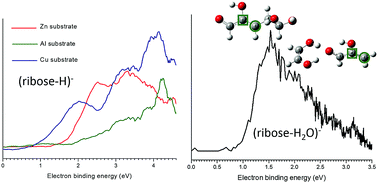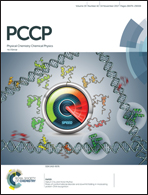Anionic ribose related species explored through PES experiments, DFT calculations, and through comparison with anionic fructose species†
Abstract
Ribose related species, (ribose-H)− and (ribose-H2O)−, are investigated through anion photoelectron spectroscopy (PES) combined with density functional theory (DFT) calculations. Their vertical detachment energies (VDEs) are experimentally determined and their anionic structures with positional and conformational isomers are definitively assigned. The ribose− parent anion is not detected in the present experiments. (ribose-H)− and (ribose-H2O)− anions can be accessed as the characteristic fragmentation ions of the parent species. Generation of (ribose-H)− through the matrix assisted laser desorption ionization (MALDI) process is sample desorption substrate dependent, while generation of (ribose-H2O)− is independent of a wide range of desorption substrates. Both conformational and positional isomers of (ribose-H)− are identified in the gas phase. Two types of positional isomers of (ribose-H2O)− (both from open chain structures) are assigned to contribute to two different components of the observed PES feature. The dehydration process can be thermodynamically accessed through both the parent anion and the neutral. A comparison between the PES and DFT results of ribose and fructose leads to the general conclusions: (1) ribose− open chain structures are more likely to lose hydrogen from C atoms than fructose− open chain structures, especially from (2)C and (4)C positions; (2) ribofuranose− has a relatively higher propensity for loss of H than does fructofuranose− in our MALDI/ablation process; and (3) the ribofuranose− anion has lower decomposition probability through loss of water compared to the fructofuranose− anion.



 Please wait while we load your content...
Please wait while we load your content...